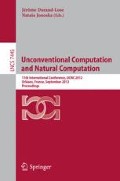Abstract
Generally, phenomena of spontaneous pattern formation are random and repetitive, whereas elaborate devices are the deterministic product of human design. Yet, biological organisms and collective insect constructions are exceptional examples of complex systems that are both self-organized and architectured. Can we understand their precise self-formation capabilities and integrate them with technological planning? Can physical systems be endowed with information, or informational systems be embedded in physics, to create autonomous morphologies and functions? A new field of research, Morphogenetic Engineering, was established [1] to explore the modeling and implementation of “self-architecturing” systems. Particular emphasis is set on the programmability and computational abilities of self-organization, properties that are often underappreciated in complex systems science—while, conversely, the benefits of self-organization are often underappreciated in engineering methodologies.
Access this chapter
Tax calculation will be finalised at checkout
Purchases are for personal use only
References
Doursat, R., Sayama, H., Michel, O.: Morphogenetic Engineering: Reconciling self-organization and architecture. In: Morphogenetic Engineering: Toward Programmable Complex Systems. NECSI “Studies on Complexity”. Springer (2012)
Doursat, R., Sánchez, C.A., Dordea, R., Fourquet, D., Kowaliw, T.: Embryomorphic Engineering: Emergent innovation by evolutionary development. In: Doursat, R., Sayama, H., Michel, O. (eds.) Morphogenetic Engineering: Toward Programmable Complex Systems. NECSI “Studies on Complexity”. Springer (2012)
Author information
Authors and Affiliations
Editor information
Editors and Affiliations
Rights and permissions
Copyright information
© 2012 Springer-Verlag Berlin Heidelberg
About this paper
Cite this paper
Doursat, R. (2012). Advances in Embryomorphic Engineering. In: Durand-Lose, J., Jonoska, N. (eds) Unconventional Computation and Natural Computation. UCNC 2012. Lecture Notes in Computer Science, vol 7445. Springer, Berlin, Heidelberg. https://doi.org/10.1007/978-3-642-32894-7_3
Download citation
DOI: https://doi.org/10.1007/978-3-642-32894-7_3
Publisher Name: Springer, Berlin, Heidelberg
Print ISBN: 978-3-642-32893-0
Online ISBN: 978-3-642-32894-7
eBook Packages: Computer ScienceComputer Science (R0)

